Research on Regional Resilience After Flood-Waterlogging Disasters Under the Concept of Urban Resilience Based on DEMATEL-TOPSIS-AISM
Abstract
1. Introduction
2. Literature
2.1. Flood-Waterlogging Disasters
2.2. Urban Resilience
- (1)
- Infrastructure Recovery
- (2)
- Social Recovery
- (3)
- Economic Recovery
3. Materials and Methods
3.1. Study Areas
3.2. Research Methodology
- Step 1. Establishing the Direct Impact Matrix.
- Step 2. Establishing the Comprehensive Impact Matrix.
- Step 3. Calculating Impact Degree, Affected Degree and Centrality.
- Step 4. Eliminating Inefficient Indicators.
- Step 5. Standardization Processing.
- Step 6. Constructing the Weighted Standardized Decision Matrix V.
- Step 7. Determining the Positive Ideal Solution Y+ and Negative Ideal Solution Y−.
- Step 8. Calculating the Geometric Distances from the Positive and Negative Ideal
- Step 9. Calculating the Closeness Coefficient to the Positive Ideal Solution.
- Step 10. Calculating the adjacency matrix H.
- Step 11. Determining the reachability matrix K.
- Step 12. Determining the reduced-point matrix K′ and the reduced-edge matrix S′.
- Step 13. Obtaining the general skeleton matrix S.
- Step 14. Determining the hierarchy of the AISM model.
- Step 15. Constructing the AISM hierarchical model.
3.3. Construction of the Evaluation Index System
3.3.1. Data Sources
- Data for the DEMATEL model were collected using the expert scoring method.
- Indicator data for the TOPSIS and AISM models were compiled from the Beijing Statistical Yearbook (2014–2023) and the Beijing Fangshan District Statistical Yearbook (2014–2023), accessed via the China National Knowledge Infrastructure (CNKI) and the Beijing Municipal People’s Government website. This provided a decade (2014–2023) of natural, ecological, and socio-economic indicator data for Fangshan District.
3.3.2. Index System
4. Results
4.1. DEMATEL Model Results Analysis
4.2. TOPSIS Model Results Analysis
4.3. AISM Model Results Analysis
- (1)
- Ecological Resilience Dimension
- (2)
- Social Resilience Dimension
- (3)
- Engineering Resilience Dimension
- (4)
- Economic Resilience Dimension
- (5)
- Institutional Resilience Dimension
5. Discussion
5.1. The Ascendancy of Informational and Foundational Drivers
5.2. The Paradox of Performance: Decoupling Economic Capacity from Systemic Robustness
5.3. The Hierarchical Lens: From Flat Indicators to a System of Causal Pathways
6. Conclusions
Author Contributions
Funding
Institutional Review Board Statement
Informed Consent Statement
Data Availability Statement
Acknowledgments
Conflicts of Interest
References
- Kurosaki, T. Household Level Recovery after floods in Tribal and conflict-ridden Society. World Dev. 2017, 94, 51–63. [Google Scholar] [CrossRef]
- Rosselló, J.; Becken, S.; Santana-Gallego, M. The effects of natural disasters on international tourism: A global analysis. Tour. Manag. 2020, 79, 104080. [Google Scholar] [CrossRef]
- Sutton, J.; Arku, G. Regional Economic Resilience: Towards a system approach. Reg. Stud. Reg. Sci. 2022, 9, 497–512. [Google Scholar] [CrossRef]
- Ministry of Water Resources of the People’s Republic of China. China Flood and Drought Disaster Prevention Bulletin 2023; China Water & Power Press: Beijing, China, 2024. [Google Scholar]
- Leaning, J.; Guha-Sapir, D. Natural Disasters, Armed Conflict, and Public Health. N. Engl. J. Med. 2014, 370, 783. [Google Scholar] [CrossRef]
- Lee, M.; Basu, D. An Integrated Approach for Resilience and Sustainability in Geotechnical Engineering. Indian Geotech. J. 2018, 48, 207–234. [Google Scholar] [CrossRef]
- Berkes, F.; Ross, H. Panarchy and community resilience: Sustainability science and policy implications. Environ. Sci. Policy 2016, 61, 185–193. [Google Scholar] [CrossRef]
- Klein, R.J.; Nicholls, R.J.; Thomalla, F. Resilience to natural hazards: How useful is this concept? Glob. Environ. Change Part B Environ. Hazards 2003, 5, 35–45. [Google Scholar] [CrossRef]
- Liu, W.; Zhou, J.; Li, X.; Zheng, H.; Liu, Y. Urban resilience and its spatial correlation from multidimensional perspective: A case study of four province North-South Seismic Belt, China. Sustain. Cities Soc. 2024, 101, 105109. [Google Scholar] [CrossRef]
- Holling, C.S. Resilience and Stability of Ecological Systems. Annu. Rev. Ecol. Evol. Syst. 1973, 4, 1–23. [Google Scholar] [CrossRef]
- Amirzadeh, M.; Sobhaninia, S.; Sharifi, A. Urban resilience: Vague or not an evolutionary concept? Sustain. Cities Soc. 2022, 81, 103853. [Google Scholar] [CrossRef]
- Shi, Y.; Zhang, T.; Jiang, Y. Digital economy, technological innovation and urban resilience. Sustainability 2023, 15, 9250. [Google Scholar] [CrossRef]
- Zhu, C.H.; Xia, J.Q.; Chen, Q.; Hou, J.M. Simulation of Urban Flood Process and Risk Assessment Based on SWMM Model. J. Catastrophol. 2018, 33, 224–230. [Google Scholar]
- Qin, P.C.; Zhou, Y.H.; Liu, H.S.; Xia, Z.H. Assessment of Crop Loss from Rainstorm and Flood Disasters Based on Hydrodynamic Model: A Case Study of Jianghan Plain. Chin. J. Agrometeorol. 2025, 46, 420–431. [Google Scholar]
- Zhou, X.J.; Wang, B.J.; Fu, C.; Liu, W.C.; Liu, L.; Song, Q. Rainstorm Flood Risk Zoning in Taohe River Basin Based on Submergence Model. Modern Agric. Sci. Technol. 2016, 178–180+189. [Google Scholar]
- Li, J.Q.; Li, Y.; Huang, K. Annual Flood Disaster Assessment Model and Application Based on Critical-Weighted Grey Correlation Analysis. China Rural Water Hydropower 2024, 36, 21–29. [Google Scholar]
- Li, M.Q.; Li, G.Q.; Xie, Z.H. Flood Disaster Assessment and Recovery Integrating Multi-Source Remote Sensing Data: A Case Study of the “7·20” Rainstorm Disaster in Henan Province. Remote Sens. Nat. Resour. 2024, 36, 250–266. [Google Scholar]
- Sun, H.H.; Cheng, X.F.; Dai, M.Q.; Wang, X.; Kang, H.D. Study on the influence factors and evaluation index system of regional flood disaster resilience based on dematel method-taking chaohu basin as a case. Resour. Environ. Yangtze Basin 2015, 24, 1577–1583. [Google Scholar]
- Qasim, S.; Qasim, M.; Shrestha, R.P.; Khan, A.N.; Tun, K.; Ashraf, M. Community resilience to flood hazards in Khyber Pukhthunkhwa province of Pakistan. Int. J. Disaster Risk Reduct. 2016, 18, 100–106. [Google Scholar] [CrossRef]
- Huang, C.F. Discussion on the Basic Definition of Natural Disasters. J. Nat. Disasters 2009, 18, 41–50. [Google Scholar]
- Li, Y.F. Research on Natural Disasters and Emergency Management; Economic Daily Press: Beijing, China, 2017. [Google Scholar]
- Saptono, Y.; Rustiadi, E.; Barus, B.; Pravitasari, A.E. Systematic Literature Review: Research Development of Urban Resilience in Metropolitan Areas. Sustainability 2025, 17, 7380. [Google Scholar] [CrossRef]
- Xiao, J.; Boschma, R.; Andersson, M. Resilience in the European Union: The effect of the 2008 crisis on the ability of regions in Europe to develop new industrial specializations. Ind. Corp. Change 2017, 27, 15–47. [Google Scholar] [CrossRef]
- Peng, C.; Yuan, M.; Gu, C.; Peng, Z.; Ming, T. A review of the theory and practice of regional resilience. Sustain. Cities Soc. 2017, 29, 86–96. [Google Scholar] [CrossRef]
- Dalziell, E.P.; McManus, S.T. Resilience, Vulnerability and Adaptive Capacity: Implications for Sistems Performance; International Forum for Engineering Decision Making (IFED): Switzerland, 2004. [Google Scholar]
- Rockefeller Foundation and Arup. City Resilience Index: Research Report Volume 1 Desk Study. New York and London: The Rockefeller Foundation: With Ove Arup & Partners International. April 2014. Available online: https://www.arup.com/globalassets/downloads/insights/city-resilience-index.pdf (accessed on 5 August 2024).
- Olson, M. The Logic of Collective Action: Public Goods and the Theory of Groups; Chen, Y.; Guo, Y.; Li, C., Translators; Gezhi Publishing House: Shanghai, China, 2008. [Google Scholar]
- Wildavsky, A. Searching for Safety; Transaction Books: New Brunswich, NJ, USA, 1988; p. 253. [Google Scholar]
- Rose, A. Defining and Measuring Economic Resilience to Disasters. Disaster Prev. Manag. 2004, 13, 307–314. [Google Scholar] [CrossRef]
- Adger, W.N. Social and ecological resilience: Are they related? Prog. Hum. Geogr. 2000, 24, 347–364. [Google Scholar] [CrossRef]
- Obrist, B.; Pfeiffer, C.; Henley, R. Multi-layered social resilience: A new approach in mitigation research. Prog. Dev. Stud. 2010, 10, 283–293. [Google Scholar] [CrossRef]
- Paton, D.; Johnston, D. Disasters and communities: Vulnerability, resilience and preparedness. Disaster Prev. Manag. 2001, 10, 270–277. [Google Scholar] [CrossRef]
- Chen, M.R.; Fu, J.; Wang, T. Exploring Policy Instruments for Micro-Regeneration in Guangzhou from the Perspective of Resilient Cities. Planners 2023, 39, 117–123. [Google Scholar]
- Juan-García, P.; Butler, D.; Comas, J.; Darch, G.; Sweetapple, C.; Thornton, A.; Corominas, L. Resilience theory incorporated into urban wastewater systems management. State of the art. Water Res. 2017, 115, 149–161. [Google Scholar] [CrossRef]
- Chen, C.K.; Chen, Y.Q.; Shi, B.; Xu, T. Urban Resilience Assessment Model under Rainstorm Flood Disaster Scenarios. China Saf. Sci. J. 2018, 28, 1–6. [Google Scholar]
- Pimm, S.L. The complexity and stability of ecosystems. Nature 1984, 307, 321–326. [Google Scholar] [CrossRef]
- Shi, Y.; Jiang, Y. Knowledge mapping and emerging trends of urban resilient infrastructure research in urban studies: Precedent work, current progress and future perspectives. Sustain. Cities Soc. 2024, 107, 105455. [Google Scholar]
- Ahern, J. From fail-safe to safe-to-fail: Sustainability and resilience in the new urban world. Landsc. Urban Plan. 2011, 100, 341–343. [Google Scholar]
- Soz, S.A.; Kryspin-Watson, J.; Stanton-Geddes, Z. The Role of Green Infrastructure Solutions in Urban Flood Risk Management; World Bank: Washington, DC, USA, 2016. [Google Scholar]
- Aldrich, D.P. Building Resilience: Social Capital in Post-Disaster Recovery; University of Chicago Press: Chicago, IL, USA, 2012. [Google Scholar]
- Norris, F.H.; Stevens, S.P.; Pfefferbaum, B.; Wyche, K.F.; Pfefferbaum, R.L. Community resilience as a metaphor, theory, set of capacities, and strategy for disaster readiness. Am. J. Community Psychol. 2008, 41, 127–150. [Google Scholar] [CrossRef]
- Mileti, D.S. Disasters by Design: A Reassessment of Natural Hazards in the United States; Joseph Henry Press: Washington, DC, USA, 1999. [Google Scholar]
- Adam, R.; Dongsoon, L. Business interruption losses from natural hazards: Conceptual and methodological issues in the case of the Northridge earthquake. Glob. Environ. Change Part B Environ. Hazards 2002, 4, 1–14. [Google Scholar] [CrossRef]
- Hallegatte, S. Economic Resilience: Definition and Measurement; World Bank Policy Research Working Paper; World Bank: Washington, DC, USA, 2014; p. 6852. [Google Scholar]
- Cutter, S.L.; Barnes, L.; Berry, M.; Burton, C.; Evans, E.; Tate, E.; Webb, J. A place-based model for understanding community resilience to natural disasters. Glob. Environ. Change 2008, 18, 598–606. [Google Scholar] [CrossRef]
- Tierney, K. The Social Roots of Risk: Producing Disasters, Promoting Resilience; Stanford University Press: Redwood City, CA, USA, 2014. [Google Scholar]
- Proag, V. The concept of vulnerability and resilience. Procedia Econ. Financ. 2014, 18, 369–376. [Google Scholar] [CrossRef]
- Chen, W.; Wang, W.; Huang, G.; Wang, J. An XGBoost–SHAP approach to quantifying morphological impact on urban flooding susceptibility. J. Hydrol. 2023, 617 Pt B, 129085. [Google Scholar]
- Liu, Z.; Wang, T.; Perera, A.T.M.; He, B.J.; Huang, Z.; Wang, L.; Hong, B. Multi-objective optimisation of integrated grey-green infrastructure in response to climate change from a life cycle perspective. J. Clean. Prod. 2023, 430, 139699. [Google Scholar]
- Wang, W.T.; Qian, P.B.; Gan, Y.L.; Song, T.X.; Xie, Y.Q. The Correlation Mechanism and Transmission Path of University Library User Experience Influencing Factors: Evolution Based on ADSM-MICMAC Model. Libr. Sci. Res. 2022, 54–66. [Google Scholar]
- National Commission for Disaster Reduction. The 14th Five-Year Plan for National Comprehensive Disaster Prevention and Reduction [EB/OL]. 21 July 2022. Available online: https://www.mem.gov.cn/gk/zfxxgkpt/fdzdgknr/202207/t20220721_418698.shtml (accessed on 28 December 2024).
- China Meteorological Administration; National Development and Reform Commission. The 14th Five-Year Plan for National Meteorological Development [EB/OL]. 24 November 2021. Available online: https://www.cma.gov.cn/zfxxgk/gknr/ghjh/202112/t20211208_4295610.html (accessed on 28 December 2024).
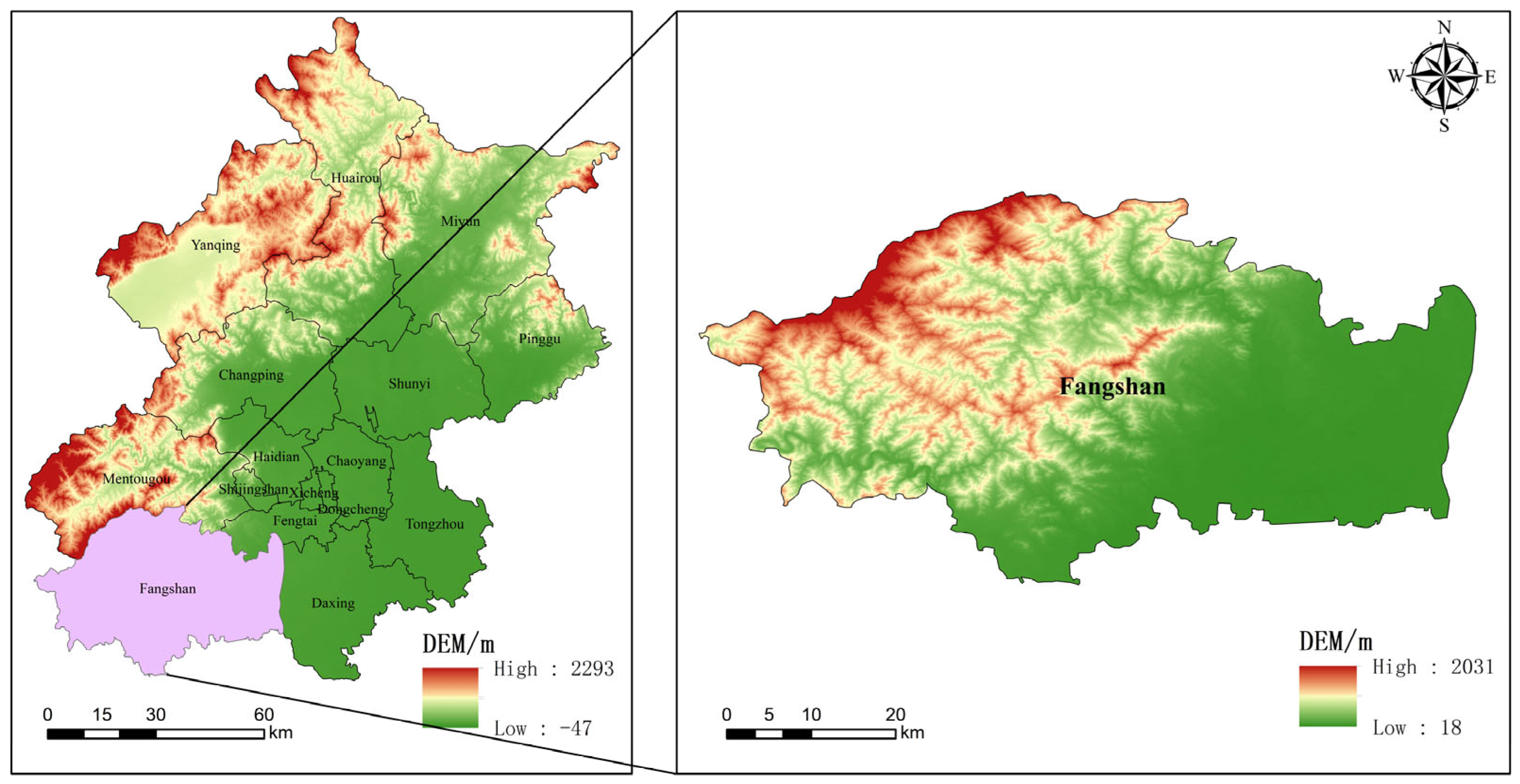
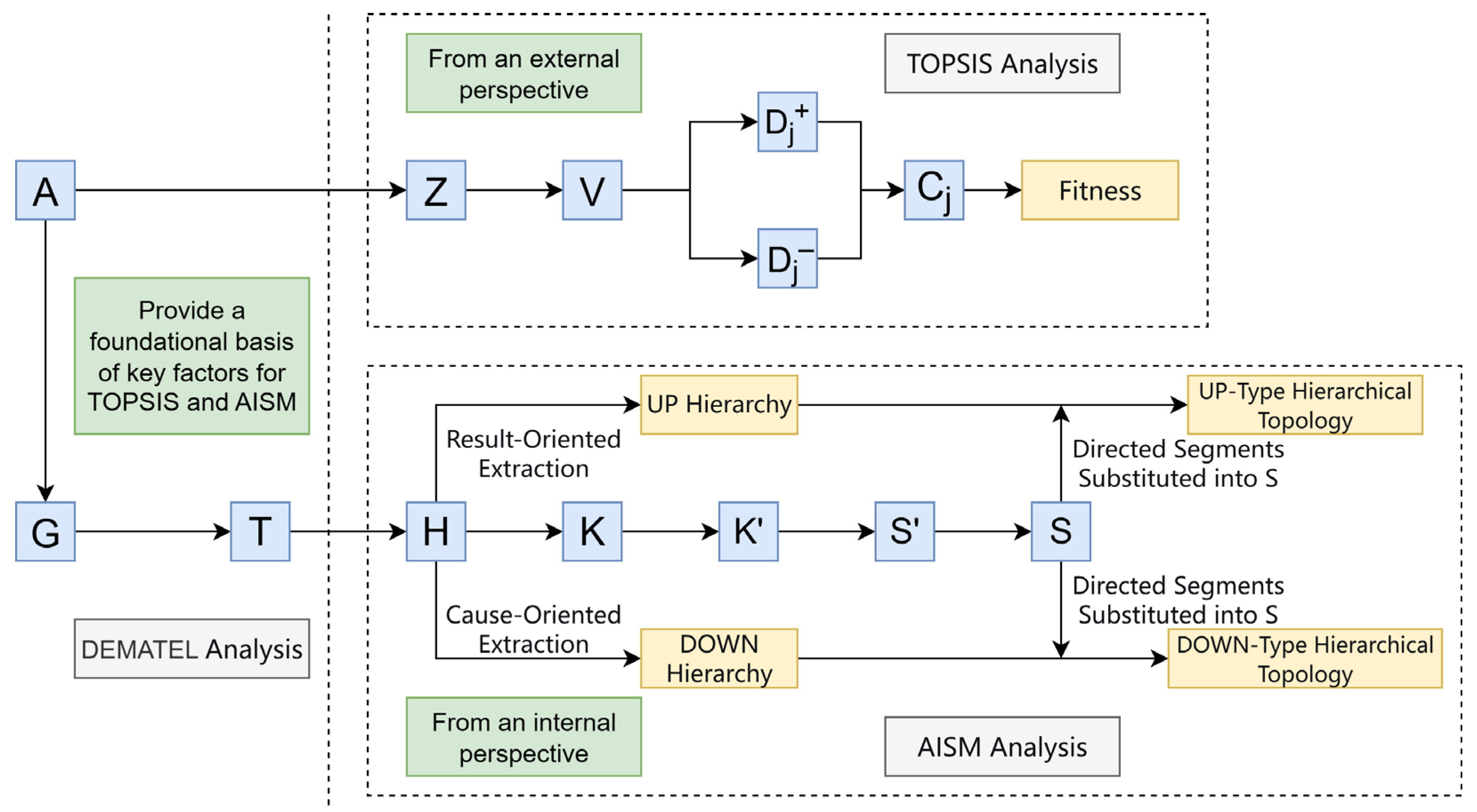
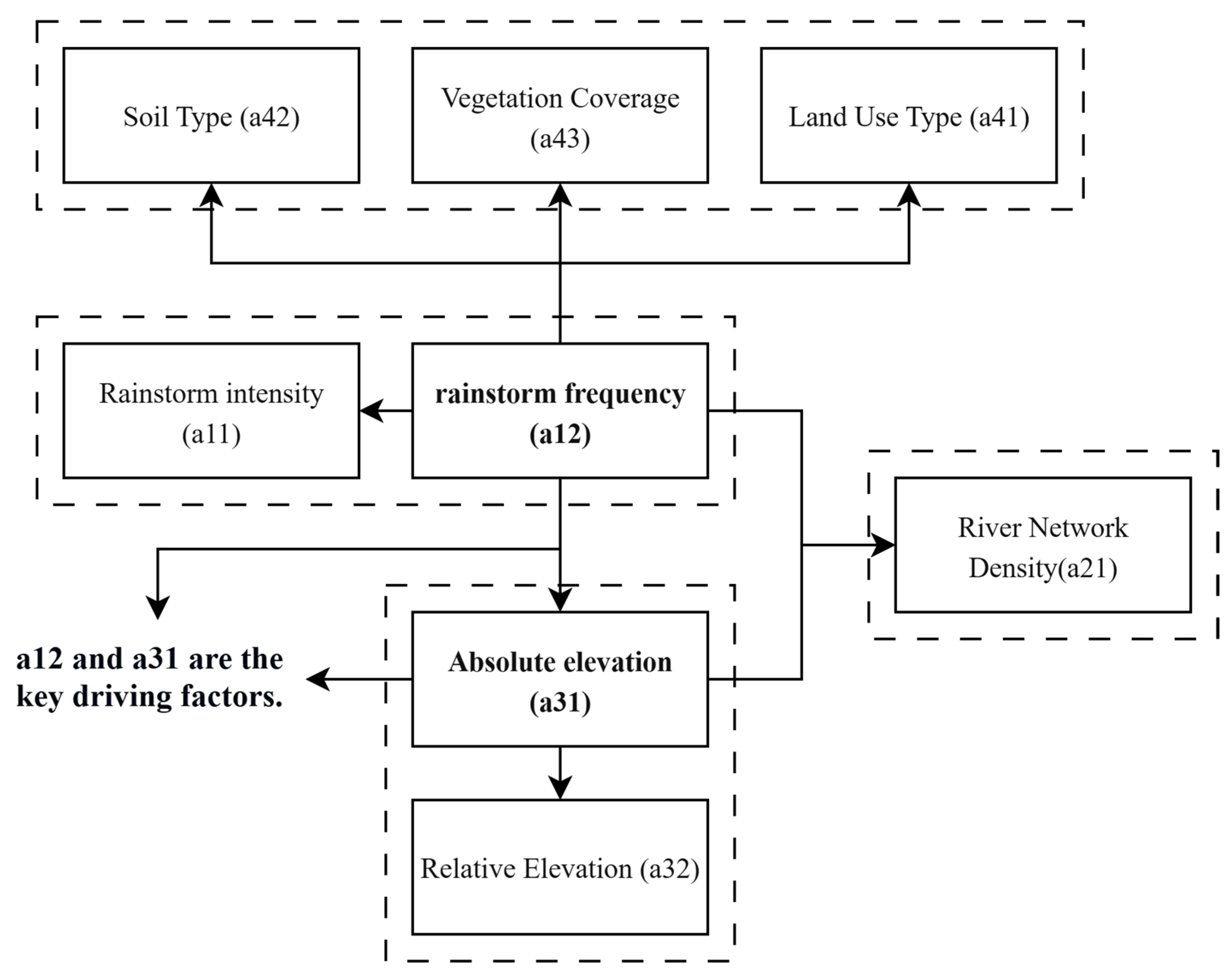
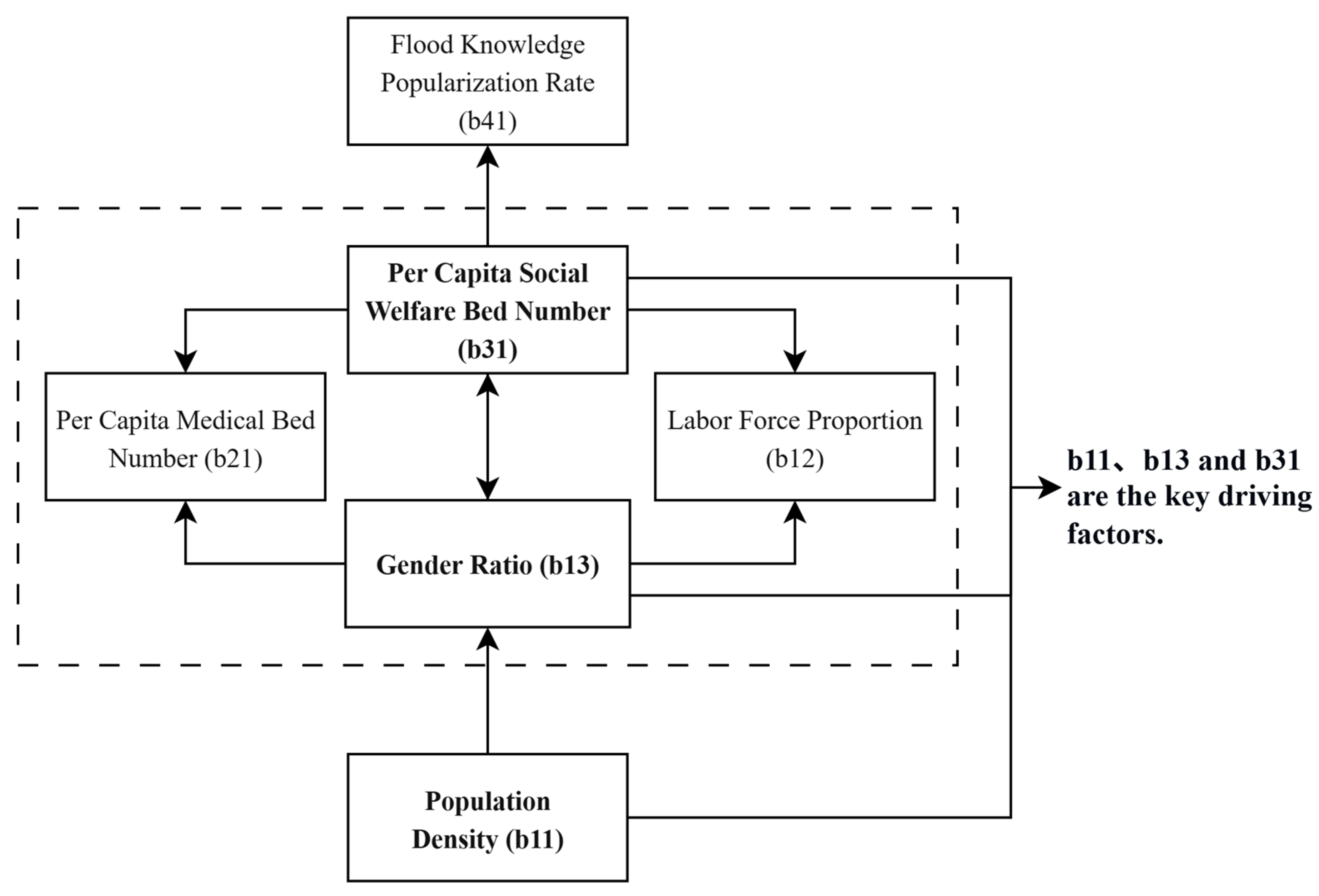
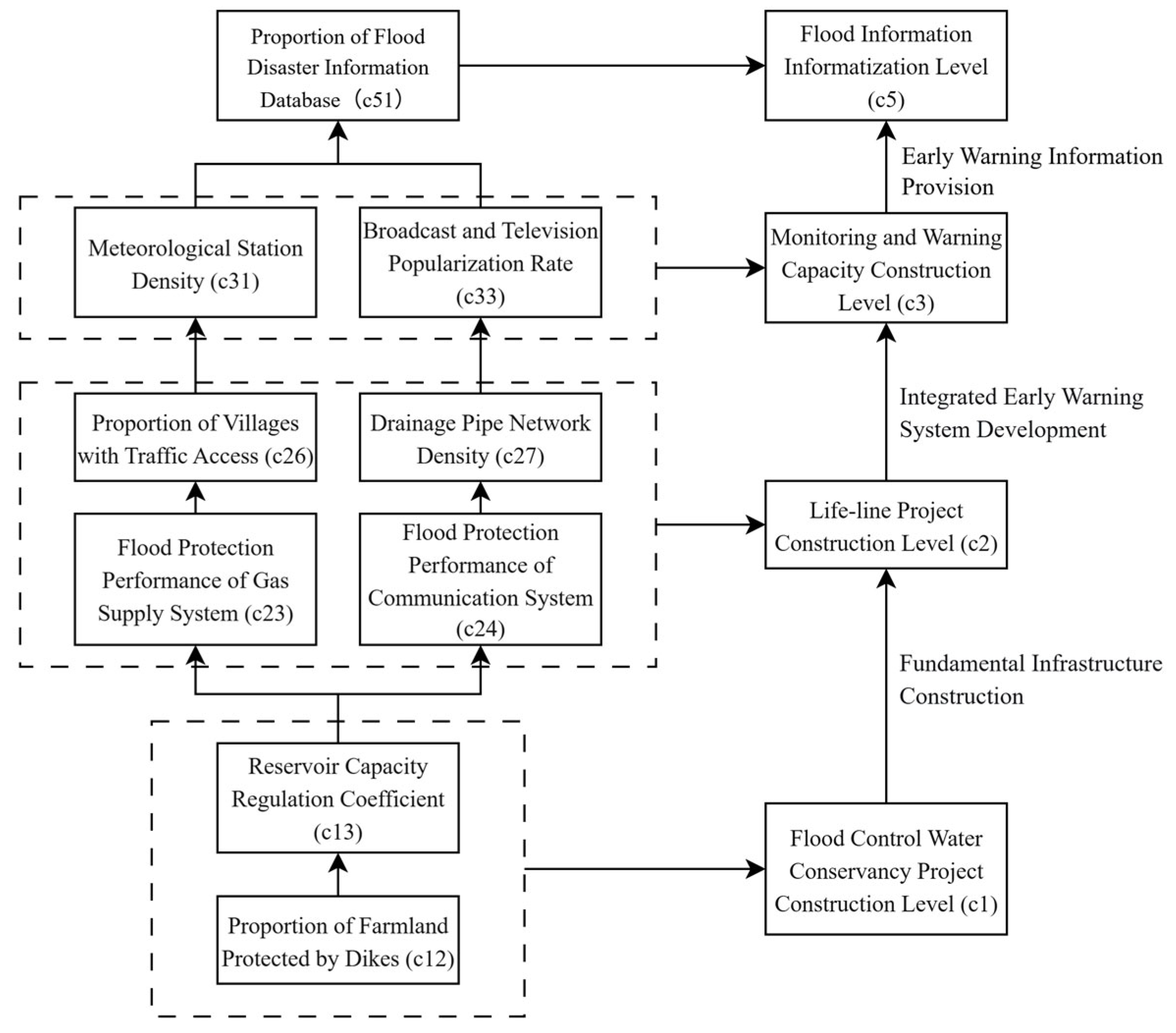
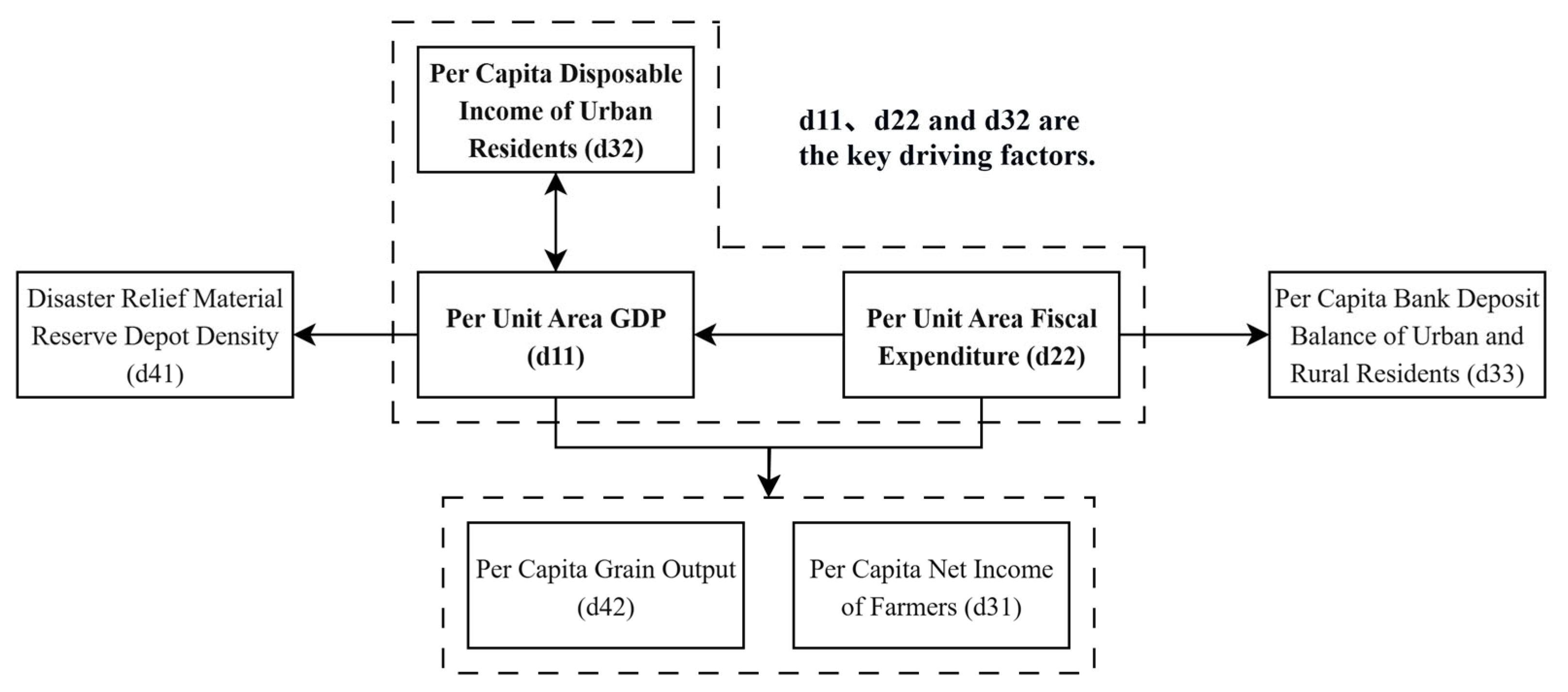
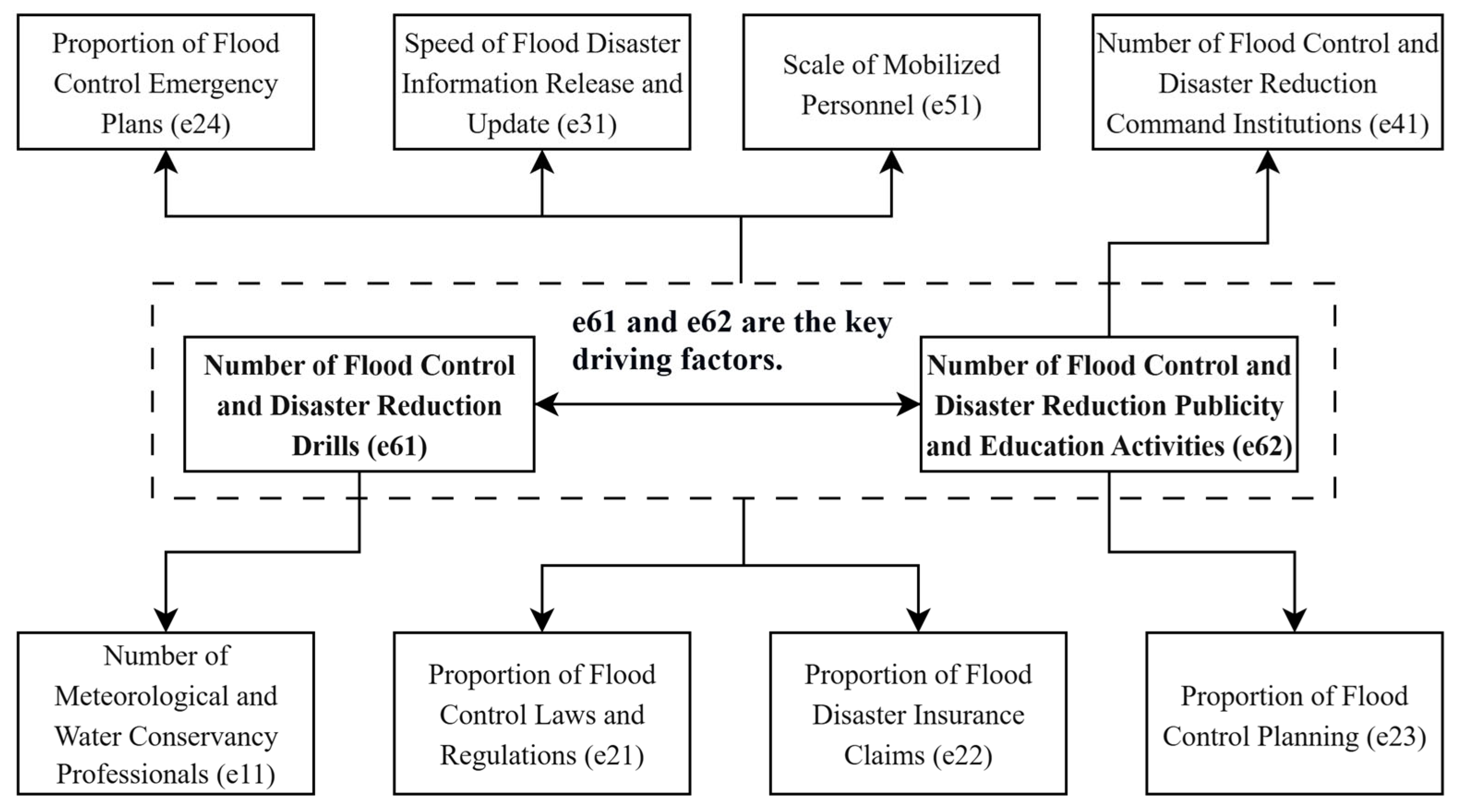
| Perspective | Definition | Scholars |
|---|---|---|
| Ecological Perspective | The capacity of socio-economic systems to withstand shocks, recover from crises, and continue to adapt autonomously to external changes. | Xiao, J. et al. [23] and Peng, C. et al. [24] |
| It refers to the ability of a system to return relatively quickly to its original state or, through self-adjustment and transformation, attain a new equilibrium, while maintaining the normal operation of its structure and functions. | Dalziell, E.P. [25] | |
| Engineering Perspective | The capacity of quality infrastructure and ecosystems to protect, provision for, and connect communities during times of crisis. | Rockefeller Foundation [26] |
| The bearing capacity and rapid recovery capability of hardware infrastructure systems—such as urban buildings, roads, and transportation networks—to withstand damage caused by external shocks or abrupt changes and quickly return to their original state. | Olson M [27] | |
| The ability of a system to cope with sporadic disasters and return to an equilibrium level, emphasizing robustness during accidental hazards and the capacity for recovery and adaptation post-impact. | Wildavsky A. et al. [28] | |
| Economic Perspective | The ability of an urban system to implement flexible strategies to avoid potential losses in the wake of sporadic disasters. | Rose A. et al. [29] |
| Social Perspective | The capacity of a group or community to confront threats and overcome external pressures and disturbances arising from social, political, and environmental changes by accessing capital and creating opportunities. | Adger, W.N. [30], Obrist, B. [31] |
| The ability of a system to maintain normal performance, mobilize resources, and address challenges under external disturbances. | Paton D. et al. [32] | |
| Organizational and Comprehensive Perspective | The capacity of a city to ensure its safe operation in the face of various disasters and risks by enhancing the coupling effects of its economic, social, institutional, and infrastructural systems, thereby improving its resistance, adaptability, rapid recovery, and transformative learning capabilities. | Chen, M.R. et al. [33] |
| First-Level Indicator | Second-Level Indicator | Third-Level Indicator |
|---|---|---|
| Ecological (A) | Precipitation Factor (a1) | Rainstorm intensity (a11) |
| Frequency of Heavy Rainfall (a12) | ||
| Water System Factor (a2) | River Network Density (a21) | |
| Topographic Factor (a3) | Absolute Elevation (a31) | |
| Relative Elevation (a32) | ||
| Land Factor (a4) | Land Use Type (a41) | |
| Soil Type (a42) | ||
| Vegetation Coverage (a43) | ||
| Social (B) | Population Factor (b1) | Population Density (b11) |
| Labor Force Proportion (b12) | ||
| Gender Ratio (b13) | ||
| Medical and Health Rescue Capacity (b2) | Per Capita Medical Bed Number (b21) | |
| Social Security Capacity (b3) | Per Capita Social Welfare Bed Number (b31) | |
| Public Disaster Prevention and Reduction Awareness (b4) | Flood Knowledge Popularization Rate (b41) | |
| Engineering (C) | Flood Control Water Conservancy Project Construction Level (c1) | Proportion of Population Protected by Dikes (c11) |
| Proportion of Farmland Protected by Dikes (c12) | ||
| Reservoir Capacity Regulation Coefficient (c13) | ||
| Proportion of Farmland with Drought and Flood Protection (c14) | ||
| Proportion of Drainage Area (c15) | ||
| Life-line Project Construction Level (c2) | Traffic Density and Accessibility (c21) | |
| Proportion of Villages Benefiting from Tap Water (c22) | ||
| Flood Protection Performance of Gas Supply System (c23) | ||
| Flood Protection Performance of Communication System (c24) | ||
| Flood Protection Performance of Power Supply System (c25) | ||
| Proportion of Villages with Traffic Access (c26) | ||
| Drainage Pipe Network Density (c27) | ||
| Per Capita Vehicle Ownership (c28) | ||
| Monitoring and Warning Capacity Construction Level (c3) | Meteorological Station Density (c31) | |
| Hydrological Monitoring Station Density (c32) | ||
| Broadcast and Television Popularization Rate (c33) | ||
| Mobile Phone Popularization Rate (c34) | ||
| Internet Popularization Rate (c35) | ||
| Building Flood Protection Capacity (c4) | Proportion of Reinforced Concrete Houses (c41) | |
| Flood Information Informatization Level (c5) | Proportion of Flood Disaster Information Database (c51) | |
| Economic (D) | Regional Economic Strength (d1) | Per Unit Area GDP (d11) |
| Proportion of Agricultural Output Value (d12) | ||
| Government Fiscal Support Capacity (d2) | Per Unit Area Fiscal Revenue (d21) | |
| Per Unit Area Fiscal Expenditure (d22) | ||
| Personal Financial Support Capacity (d3) | Per Capita Net Income of Farmers (d31) | |
| Per Capita Disposable Income of Urban Residents (d32) | ||
| Per Capita Bank Deposit Balance of Urban and Rural Residents (d33) | ||
| Material Support Capacity (d4) | Disaster Relief Material Reserve Depot Density (d41) | |
| Per Capita Grain Output (d42) | ||
| Institutional (E) | Professional Talent Team Construction Level (e1) | Number of Meteorological and Water Conservancy Professionals (e11) |
| Disaster Policy and Regulations (e2) | Proportion of Flood Control Laws and Regulations (e21) | |
| Proportion of Flood Disaster Insurance Claims (e22) | ||
| Proportion of Flood Control Planning (e23) | ||
| Proportion of Flood Control Emergency Plans (e24) | ||
| Flood Disaster Information Management and Service Capacity (e3) | Speed of Flood Disaster Information Release and Update (e31) | |
| Command System Construction Level (e4) | Number of Flood Control and Disaster Reduction Command Institutions (e41) | |
| Social Mobilization Capacity (e5) | Scale of Mobilized Personnel (e51) | |
| Disaster Reduction Culture Construction Level (e6) | Number of Flood Control and Disaster Reduction Drills (e61) | |
| Number of Flood Control and Disaster Reduction Publicity and Education Activities (e62) |
| Third-Level Indicator | Impact Degree | R Affected Degree | Centrality | Cause Degree |
|---|---|---|---|---|
| a12 | 0.889 | 0.164 | 1.052 | 0.725 |
| a31 | 0.061 | 0.166 | 0.227 | −0.105 |
| b11 | 0.149 | 0.133 | 0.282 | 0.016 |
| b13 | 0.041 | 0.288 | 0.329 | −0.247 |
| b31 | 0.589 | 0.197 | 0.786 | 0.393 |
| c12 | 0.11 | 0.179 | 0.289 | −0.07 |
| c13 | 0.639 | 0.184 | 0.823 | 0.455 |
| c23 | 0.118 | 0.222 | 0.341 | −0.104 |
| c24 | 0.045 | 0.146 | 0.191 | −0.101 |
| c26 | 0.181 | 0.241 | 0.422 | −0.061 |
| c27 | 0.084 | 0.151 | 0.235 | −0.067 |
| c31 | 0.709 | 0.271 | 1.18 | 0.638 |
| c33 | 0.049 | 0.135 | 0.184 | −0.086 |
| c51 | 1.153 | 0.187 | 1.34 | 0.966 |
| d11 | 0.76 | 0.115 | 0.875 | 0.645 |
| d22 | 0.701 | 0.116 | 0.817 | 0.585 |
| d32 | 0.068 | 0.087 | 0.155 | −0.019 |
| e61 | 0.091 | 0.119 | 0.21 | −0.027 |
| e62 | 0.781 | 0.119 | 0.899 | 0.662 |
| Item | Relative Closeness C | Ranking Result |
|---|---|---|
| Economic Resilience | 0.21200 | 1 |
| Social Resilience | 0.00140 | 2 |
| Engineering Resilience | 0.00075 | 3 |
| Ecological Resilience | 0.00060 | 4 |
| Institutional Resilience | 0.00000 | 5 |
Disclaimer/Publisher’s Note: The statements, opinions and data contained in all publications are solely those of the individual author(s) and contributor(s) and not of MDPI and/or the editor(s). MDPI and/or the editor(s) disclaim responsibility for any injury to people or property resulting from any ideas, methods, instructions or products referred to in the content. |
© 2025 by the authors. Licensee MDPI, Basel, Switzerland. This article is an open access article distributed under the terms and conditions of the Creative Commons Attribution (CC BY) license (https://creativecommons.org/licenses/by/4.0/).
Share and Cite
Zhang, H.; Luo, J.; Li, W. Research on Regional Resilience After Flood-Waterlogging Disasters Under the Concept of Urban Resilience Based on DEMATEL-TOPSIS-AISM. Sustainability 2025, 17, 9677. https://doi.org/10.3390/su17219677
Zhang H, Luo J, Li W. Research on Regional Resilience After Flood-Waterlogging Disasters Under the Concept of Urban Resilience Based on DEMATEL-TOPSIS-AISM. Sustainability. 2025; 17(21):9677. https://doi.org/10.3390/su17219677
Chicago/Turabian StyleZhang, Hong, Jiahui Luo, and Wenlong Li. 2025. "Research on Regional Resilience After Flood-Waterlogging Disasters Under the Concept of Urban Resilience Based on DEMATEL-TOPSIS-AISM" Sustainability 17, no. 21: 9677. https://doi.org/10.3390/su17219677
APA StyleZhang, H., Luo, J., & Li, W. (2025). Research on Regional Resilience After Flood-Waterlogging Disasters Under the Concept of Urban Resilience Based on DEMATEL-TOPSIS-AISM. Sustainability, 17(21), 9677. https://doi.org/10.3390/su17219677






